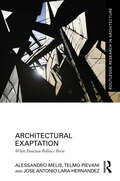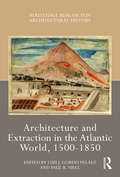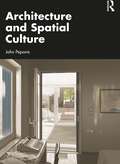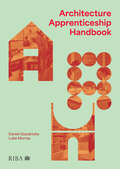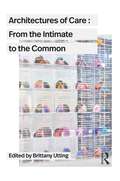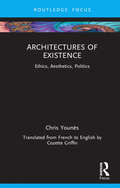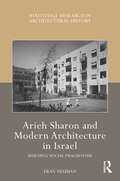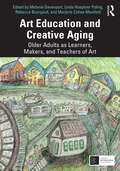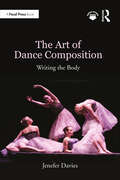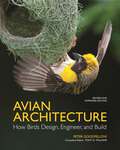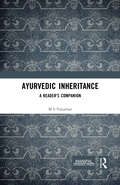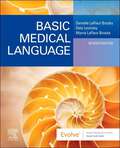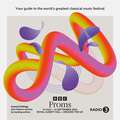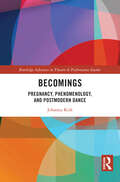- Table View
- List View
Architectural Exaptation: When Function Follows Form (Routledge Research in Architecture)
by Alessandro Melis Telmo Pievani Jose Antonio Lara-HernandezArchitectural Exaptation: When Function Follows Form focuses on the significance and the originality of the study of exaptation. It presents exaptation as an opportunity to extend architectural design towards more sustainable approaches aimed at enforcing urban resilience.The use of exaptation’s definition in architecture supports the heuristic value of cross-disciplinary studies on biology and architecture, which seem even more relevant in times of global environmental crises. This book aims to make a critique of the pre-existing and extensive paternalistic literature. Exaptation will be described as a functional shift of a structure that already had a prior, but different, function. In architecture, a functional shift of a structure that already had a function may apply to forms of decorative elements embedded in architectural components, and to both change of function of tectonic elements and the change of use of an architectural space. The book is illustrated with examples from around the globe, including China, Italy, Mexico, New Zealand, the USA and the UK, and looks at different civilizations and diverse historical periods, ranging from the urban to the architectural scale. Such examples highlight the potential and latent human creative capacity to change the use and functions, something that cities and buildings could consider when facing disturbances. Exaptation is shown as an alternative narrative to the simplifications of evolutionary puritanism. It also offers an innovative perspective and presents an opportunity to re-think the manner in which we design and redesign our cities.This book will be of interest to architecture, planning, urban design and biology researchers and students.
Architectural Exaptation: When Function Follows Form (Routledge Research in Architecture)
by Alessandro Melis Telmo Pievani Jose Antonio Lara-HernandezArchitectural Exaptation: When Function Follows Form focuses on the significance and the originality of the study of exaptation. It presents exaptation as an opportunity to extend architectural design towards more sustainable approaches aimed at enforcing urban resilience.The use of exaptation’s definition in architecture supports the heuristic value of cross-disciplinary studies on biology and architecture, which seem even more relevant in times of global environmental crises. This book aims to make a critique of the pre-existing and extensive paternalistic literature. Exaptation will be described as a functional shift of a structure that already had a prior, but different, function. In architecture, a functional shift of a structure that already had a function may apply to forms of decorative elements embedded in architectural components, and to both change of function of tectonic elements and the change of use of an architectural space. The book is illustrated with examples from around the globe, including China, Italy, Mexico, New Zealand, the USA and the UK, and looks at different civilizations and diverse historical periods, ranging from the urban to the architectural scale. Such examples highlight the potential and latent human creative capacity to change the use and functions, something that cities and buildings could consider when facing disturbances. Exaptation is shown as an alternative narrative to the simplifications of evolutionary puritanism. It also offers an innovative perspective and presents an opportunity to re-think the manner in which we design and redesign our cities.This book will be of interest to architecture, planning, urban design and biology researchers and students.
Architecture and Extraction in the Atlantic World, 1500-1850 (Routledge Research in Architectural History)
by Luis Gordo Peláez Paul NiellThis edited collection examines the development of Atlantic World architecture after 1492. In particular, the chapters explore the landscapes of extraction as material networks that brought people, space, and labor together in harvesting raw materials, cultivating agriculture for export-level profits, and circulating raw materials and commodities in Europe, Africa, and the Americas from 1500 to 1850. This book argues that histories of extraction remain incomplete without careful attention to the social, physical, and mental nexus that is architecture, just as architecture’s development in the last 500 years cannot be adequately comprehended without attention to empire, extraction, colonialism, and the rise of what Immanuel Wallerstein has called the world system. This world system was possible because of built environments that enabled resource extraction, transport of raw materials, circulation of commodities, and enactment of power relations in the struggle between capital and labor. Separated into three sections: Harvesting the Environment, Cultivating Profit, and Circulating Commodities: Networks and Infrastructures, this volume covers a wide range of geographies, from England to South America, from Africa to South Carolina. The book aims to decenter Eurocentric approaches to architectural history to expose the global circulation of ideas, things, commodities, and people that constituted the architecture of extraction in the Atlantic World. In focusing on extraction, we aim to recover histories of labor exploitation and racialized oppression of interest to the global community. The book will be of interest to researchers and students of architectural history, geography, urban and labor history, literary studies, historic preservation, and colonial studies.
Architecture and Extraction in the Atlantic World, 1500-1850 (Routledge Research in Architectural History)
This edited collection examines the development of Atlantic World architecture after 1492. In particular, the chapters explore the landscapes of extraction as material networks that brought people, space, and labor together in harvesting raw materials, cultivating agriculture for export-level profits, and circulating raw materials and commodities in Europe, Africa, and the Americas from 1500 to 1850. This book argues that histories of extraction remain incomplete without careful attention to the social, physical, and mental nexus that is architecture, just as architecture’s development in the last 500 years cannot be adequately comprehended without attention to empire, extraction, colonialism, and the rise of what Immanuel Wallerstein has called the world system. This world system was possible because of built environments that enabled resource extraction, transport of raw materials, circulation of commodities, and enactment of power relations in the struggle between capital and labor. Separated into three sections: Harvesting the Environment, Cultivating Profit, and Circulating Commodities: Networks and Infrastructures, this volume covers a wide range of geographies, from England to South America, from Africa to South Carolina. The book aims to decenter Eurocentric approaches to architectural history to expose the global circulation of ideas, things, commodities, and people that constituted the architecture of extraction in the Atlantic World. In focusing on extraction, we aim to recover histories of labor exploitation and racialized oppression of interest to the global community. The book will be of interest to researchers and students of architectural history, geography, urban and labor history, literary studies, historic preservation, and colonial studies.
Architecture and Spatial Culture
by John PeponisBuilt space supports our daily habits and our membership of communities, organizations, institutions, or social formations. Architecture and Spatial Culture argues that architecture matters because it makes the settings of our life intelligible, so that we can sustain or creatively transform them.As technological and social innovations allow us to overcome spatial constraints to communication, cooperation, and exchange, so the architecture of embodied experience reflects independent cultural choices and human values. The analysis of a wealth of examples, from urban environments to workplaces and museums, shows that built space functions pedagogically, inducing us to specific ways of seeing, understanding, and feeling, and supporting distinct patterns of cooperation and life in common.Architecture and Spatial Culture is about the principles that underpin the design and inhabitation of space. It also serves as an introduction to Space Syntax, a descriptive theory used to model the human functions of layouts. Thus, it addresses architects, students of architecture and all those working in disciplines that engage the design of the built environment and its social effects.
Architecture and Spatial Culture
by John PeponisBuilt space supports our daily habits and our membership of communities, organizations, institutions, or social formations. Architecture and Spatial Culture argues that architecture matters because it makes the settings of our life intelligible, so that we can sustain or creatively transform them.As technological and social innovations allow us to overcome spatial constraints to communication, cooperation, and exchange, so the architecture of embodied experience reflects independent cultural choices and human values. The analysis of a wealth of examples, from urban environments to workplaces and museums, shows that built space functions pedagogically, inducing us to specific ways of seeing, understanding, and feeling, and supporting distinct patterns of cooperation and life in common.Architecture and Spatial Culture is about the principles that underpin the design and inhabitation of space. It also serves as an introduction to Space Syntax, a descriptive theory used to model the human functions of layouts. Thus, it addresses architects, students of architecture and all those working in disciplines that engage the design of the built environment and its social effects.
Architecture Apprenticeship Handbook
by Daniel Goodricke Luke MurrayArchitecture apprenticeships are a new route into the profession. Having gained traction since their inception in 2018, it is an attractive route for young generations of architects to obtain their professional qualifications and earn while they learn. Aimed at prospective and current Level 7: Architect Apprentices, this guide provides the knowledge to achieve the most from your apprenticeship education, empowering your exposure in the profession within academic and professional areas. Taking you on a journey through the apprenticeship, it presents key stages of the course through precedents and will let you know what to expect from this educational route, and when to expect it. Using case studies from recent graduates and current apprentices who have excelled through this route, it features information from employers and academics involved in architecture apprenticeship courses in the UK to provide tips, advice and guidance. Designed to be interactive, you will be able to populate and annotate the book at various stages to map the key stages of your journey and reflect on your professional development.
Architecture Apprenticeship Handbook
by Daniel Goodricke Luke MurrayArchitecture apprenticeships are a new route into the profession. Having gained traction since their inception in 2018, it is an attractive route for young generations of architects to obtain their professional qualifications and earn while they learn. Aimed at prospective and current Level 7: Architect Apprentices, this guide provides the knowledge to achieve the most from your apprenticeship education, empowering your exposure in the profession within academic and professional areas. Taking you on a journey through the apprenticeship, it presents key stages of the course through precedents and will let you know what to expect from this educational route, and when to expect it. Using case studies from recent graduates and current apprentices who have excelled through this route, it features information from employers and academics involved in architecture apprenticeship courses in the UK to provide tips, advice and guidance. Designed to be interactive, you will be able to populate and annotate the book at various stages to map the key stages of your journey and reflect on your professional development.
Architectures of Care: From the Intimate to the Common
Drawing from a diverse range of interdisciplinary voices, this book explores how spaces of care shape our affective, material, and social forms, from the most intimate scale of the body to our planetary commons.Typical definitions of care center around the maintenance of a livable life, encompassing everything from shelter and welfare to health and safety. Architecture plays a fundamental role in these definitions, inscribed in institutional archetypes such as the home, the hospital, the school, and the nursery. However, these spaces often structure modes of care that prescribe gender roles, bodily norms, and labor practices. How can architecture instead engage with an expanded definition of care that questions such roles and norms, producing more hybrid entanglements between our bodies, our collective lives, and our environments? Chapters in this book explore issues ranging from disabled domesticities and nursing, unbuilding whiteness in the built environment, practices and pedagogies of environmental care, and the solidarity networks within ‘The Cloud’. Case studies include Floating University Berlin, commoning initiatives by the Black Panther party, and hospitals for the United Mine Workers of America, among many other sites and scales of care.Exploring architecture through the lenses of gender studies, labor theory, environmental justice, and the medical humanities, this book will engage students and academics from a wide range of disciplines.
Architectures of Care: From the Intimate to the Common
by Brittany UttingDrawing from a diverse range of interdisciplinary voices, this book explores how spaces of care shape our affective, material, and social forms, from the most intimate scale of the body to our planetary commons.Typical definitions of care center around the maintenance of a livable life, encompassing everything from shelter and welfare to health and safety. Architecture plays a fundamental role in these definitions, inscribed in institutional archetypes such as the home, the hospital, the school, and the nursery. However, these spaces often structure modes of care that prescribe gender roles, bodily norms, and labor practices. How can architecture instead engage with an expanded definition of care that questions such roles and norms, producing more hybrid entanglements between our bodies, our collective lives, and our environments? Chapters in this book explore issues ranging from disabled domesticities and nursing, unbuilding whiteness in the built environment, practices and pedagogies of environmental care, and the solidarity networks within ‘The Cloud’. Case studies include Floating University Berlin, commoning initiatives by the Black Panther party, and hospitals for the United Mine Workers of America, among many other sites and scales of care.Exploring architecture through the lenses of gender studies, labor theory, environmental justice, and the medical humanities, this book will engage students and academics from a wide range of disciplines.
Architectures of Existence: Ethics, Aesthetics, Politics
by Chris YounèsArchitectures of Existence proposes that philosophical thinking (ecosophical thinking) can inform the way we engage with our world and its inhabitants, as architects, designers and planners, but also as individuals, as people, and as a society. In Art et existence, Maldiney states: "For us, to inhabit is to exist". This book aims to unfold, extend, articulate and thicken this postulate by interweaving architecture, city, landscape, literature and philosophy. It takes up the synergistic lines of long-term research carried out from an ecosophical perspective. Such an attitude explores an art of existing in multiplicity, singularity and openness, manifesting the critical dimension through a reinterpretation of the knotting of the trajectories of time, humanity and its becoming. Insisting on what is between things and beings as well as on what is happening, regenerating, recycling, reviving, saving, diversifying, sparing, recreating, meditating: and so caring. These are all eco-rhythms of a different type between human and non-human, to consider ourselves in the world. In an era of uncertainty and climate threats, this book develops the margins of possibility offered by the subject of architecture. This book will be of interest to researchers and students of architecture, urban planning and philosophy.
Architectures of Existence: Ethics, Aesthetics, Politics
by Chris YounèsArchitectures of Existence proposes that philosophical thinking (ecosophical thinking) can inform the way we engage with our world and its inhabitants, as architects, designers and planners, but also as individuals, as people, and as a society. In Art et existence, Maldiney states: "For us, to inhabit is to exist". This book aims to unfold, extend, articulate and thicken this postulate by interweaving architecture, city, landscape, literature and philosophy. It takes up the synergistic lines of long-term research carried out from an ecosophical perspective. Such an attitude explores an art of existing in multiplicity, singularity and openness, manifesting the critical dimension through a reinterpretation of the knotting of the trajectories of time, humanity and its becoming. Insisting on what is between things and beings as well as on what is happening, regenerating, recycling, reviving, saving, diversifying, sparing, recreating, meditating: and so caring. These are all eco-rhythms of a different type between human and non-human, to consider ourselves in the world. In an era of uncertainty and climate threats, this book develops the margins of possibility offered by the subject of architecture. This book will be of interest to researchers and students of architecture, urban planning and philosophy.
Arieh Sharon and Modern Architecture in Israel: Building Social Pragmatism (Routledge Research in Architectural History)
by Eran NeumanArieh Sharon and Modern Architecture in Israel: Building Social Pragmatism offers the first comprehensive survey of the work of Arieh Sharon and analyzes and discusses his designs and plans in relation to the emergence of the State of Israel. A graduate of the Bauhaus, Sharon worked for a few years at the office of Hannes Mayer before returning to Mandatory Palestine. There, he established his office which was occupied in its first years in planning kibbutzim and residential buildings in Tel Aviv. After the establishment of the State of Israel in 1948, Arieh Sharon became the director and chief architect of the National Planning Department, where he was asked to devise the young country’s first national masterplan. Known as the Sharon Plan, it was instrumental in shaping the development of the new nation. During the 1950s and 1960s, Sharon designed many of Israel’s institutions, including hospitals and buildings on university campuses. This book presents Sharon’s exceptionally wide range of work and examines his perception of architecture in both socialist and pragmatist terms. It also explores Sharon’s modernist approach to architecture and his subsequent shift to Brutalist architecture, when he partnered with Benjamin Idelson in the 1950s and when his son, Eldar Sharon, joined the office in 1964. Thus, the book contributes a missing chapter in the historiography of Israeli architecture in particular and of modern architecture overall. This book will be of interest to researchers in architecture, modern architecture, Israel studies, Middle Eastern studies and migration of knowledge.
Arieh Sharon and Modern Architecture in Israel: Building Social Pragmatism (Routledge Research in Architectural History)
by Eran NeumanArieh Sharon and Modern Architecture in Israel: Building Social Pragmatism offers the first comprehensive survey of the work of Arieh Sharon and analyzes and discusses his designs and plans in relation to the emergence of the State of Israel. A graduate of the Bauhaus, Sharon worked for a few years at the office of Hannes Mayer before returning to Mandatory Palestine. There, he established his office which was occupied in its first years in planning kibbutzim and residential buildings in Tel Aviv. After the establishment of the State of Israel in 1948, Arieh Sharon became the director and chief architect of the National Planning Department, where he was asked to devise the young country’s first national masterplan. Known as the Sharon Plan, it was instrumental in shaping the development of the new nation. During the 1950s and 1960s, Sharon designed many of Israel’s institutions, including hospitals and buildings on university campuses. This book presents Sharon’s exceptionally wide range of work and examines his perception of architecture in both socialist and pragmatist terms. It also explores Sharon’s modernist approach to architecture and his subsequent shift to Brutalist architecture, when he partnered with Benjamin Idelson in the 1950s and when his son, Eldar Sharon, joined the office in 1964. Thus, the book contributes a missing chapter in the historiography of Israeli architecture in particular and of modern architecture overall. This book will be of interest to researchers in architecture, modern architecture, Israel studies, Middle Eastern studies and migration of knowledge.
Art Education and Creative Aging: Older Adults as Learners, Makers, and Teachers of Art
This text explores how art education can meaningfully address the needs of older adults as learners, makers, and teachers of art in formal and informal settings. It combines perspectives of museum educators, teacher preparation professors, art therapists, teaching artists, and older artists on what is meant by Creative Aging and the ways art education can support the health and well-being of this population. Most importantly, the book discusses what the field of art education can gain from older adult learners and creators.Chapters are organized into five sections: Creatively Aging, Meeting Older Adults’ Unique Needs, Intergenerational Art Education, Engaging Older Adults With Artworks and Objects, and In Our Own Voices: Older Adults as Learners, Makers, and Teachers. Within each section, contributors investigate themes critical to art education within aging populations such as memory loss, disability, coping with life transitions, lifelong learning, intergenerational relationships, and personal narrative. The final section focuses on accounts from older adult artists/educators, offering insights and proposing new directions for growing older creatively.Though ideal for art education faculty and students in graduate and undergraduate settings, as well as art education scholars and those teaching in multigenerational programs within community settings, this book is an expansive resource for any artist, student, or scholar interested in the links among health, well-being, and arts participation for older adults.
Art Education and Creative Aging: Older Adults as Learners, Makers, and Teachers of Art
by Melanie Davenport Linda Hoeptner Poling Rébecca Bourgault Marjorie Cohee ManifoldThis text explores how art education can meaningfully address the needs of older adults as learners, makers, and teachers of art in formal and informal settings. It combines perspectives of museum educators, teacher preparation professors, art therapists, teaching artists, and older artists on what is meant by Creative Aging and the ways art education can support the health and well-being of this population. Most importantly, the book discusses what the field of art education can gain from older adult learners and creators.Chapters are organized into five sections: Creatively Aging, Meeting Older Adults’ Unique Needs, Intergenerational Art Education, Engaging Older Adults With Artworks and Objects, and In Our Own Voices: Older Adults as Learners, Makers, and Teachers. Within each section, contributors investigate themes critical to art education within aging populations such as memory loss, disability, coping with life transitions, lifelong learning, intergenerational relationships, and personal narrative. The final section focuses on accounts from older adult artists/educators, offering insights and proposing new directions for growing older creatively.Though ideal for art education faculty and students in graduate and undergraduate settings, as well as art education scholars and those teaching in multigenerational programs within community settings, this book is an expansive resource for any artist, student, or scholar interested in the links among health, well-being, and arts participation for older adults.
The Art of Dance Composition: Writing the Body
by Jenefer DaviesThe Art of Dance Composition: Writing the Body is an introduction to modern dance composition, providing clear and structured approaches to designing and defining movement that demystify the creative process.The book introduces the concepts of creating authentic movement, processes for gathering and ordering compositional elements, and the ways in which theme, story, and design relate to bodies moving through space. It approaches the practice of composition from many avenues, including the use of digital tools such as video and video editing software, digital mapping, and motion capture, and through improvisation, sourced gestures, and inspiration from visual art, found objects, and chance methodology. Flowcharts that organize and provide a framework for making dance are included, equipping readers with a clear roadmap for creating their own work.Filled with practical advice, this book is suitable for all aspiring choreographers.The Art of Dance Composition: Writing the Body includes access to performance videos that demonstrate the concepts illustrated in the book. To access the videos, visit www.daviesanddancers.com/links-to-writing-the-body.
The Art of Dance Composition: Writing the Body
by Jenefer DaviesThe Art of Dance Composition: Writing the Body is an introduction to modern dance composition, providing clear and structured approaches to designing and defining movement that demystify the creative process.The book introduces the concepts of creating authentic movement, processes for gathering and ordering compositional elements, and the ways in which theme, story, and design relate to bodies moving through space. It approaches the practice of composition from many avenues, including the use of digital tools such as video and video editing software, digital mapping, and motion capture, and through improvisation, sourced gestures, and inspiration from visual art, found objects, and chance methodology. Flowcharts that organize and provide a framework for making dance are included, equipping readers with a clear roadmap for creating their own work.Filled with practical advice, this book is suitable for all aspiring choreographers.The Art of Dance Composition: Writing the Body includes access to performance videos that demonstrate the concepts illustrated in the book. To access the videos, visit www.daviesanddancers.com/links-to-writing-the-body.
Avian Architecture Revised and Expanded Edition: How Birds Design, Engineer, and Build
by Peter GoodfellowThe essential illustrated guide to how birds design and build their nests—now fully revised and expandedBirds are the most consistently inventive builders, and their nests set the bar for functional design in nature. Describing how birds design, engineer, and build their nests, Avian Architecture deconstructs all types of nests found around the world using architectural blueprints and detailed descriptions of the construction processes and engineering techniques birds use.This spectacularly illustrated book features more than 300 full-color images and more than 40 case studies that profile key species worldwide. Each chapter covers a different type of nest, from tunnel nests and mound nests to floating nests, hanging nests, woven nests, and even multiple-nest avian cities. Other kinds of avian construction—such as bowers and food stores—are also featured.Now with more case studies and an updated foreword, this revised and expanded edition includes intricate step-by-step sequences, visual spreads on nest-building materials and methods, and insightful commentary by a leading expert.Illustrates how birds around the world design, engineer, and build their nestsFeatures architectural blueprints, step-by-step sequences, visual spreads on nest-building materials and methods, and expert commentaryIncludes more than 300 full-color imagesCovers more than 100 bird species worldwide
Ayurvedic Inheritance: A Reader's Companion
by M S ValiathanThis book is a companion to Āyurvedic studies. It discusses the history and evolution of Ayurveda, its philosophy, and its practical uses in everyday life—from medicine to mental wellbeing. It harks back to the traditional Indian concept of four aspects of lifelong learning. These were instruction by the teacher, individual effort, learning from companions and lastly, wisdom gathered over a lifetime. Print edition not for sale in South Asia (India, Sri Lanka, Nepal, Bangladesh, Pakistan and Bhutan)
Ayurvedic Inheritance: A Reader's Companion
by M S ValiathanThis book is a companion to Āyurvedic studies. It discusses the history and evolution of Ayurveda, its philosophy, and its practical uses in everyday life—from medicine to mental wellbeing. It harks back to the traditional Indian concept of four aspects of lifelong learning. These were instruction by the teacher, individual effort, learning from companions and lastly, wisdom gathered over a lifetime. Print edition not for sale in South Asia (India, Sri Lanka, Nepal, Bangladesh, Pakistan and Bhutan)
Basic Medical Language with Flash Cards E-Book: Basic Medical Language with Flash Cards E-Book
by Danielle LaFleur Brooks Myrna LaFleur Brooks Dale LevinskyBuild the foundation you need to confidently communicate with your healthcare team! Basic Medical Language, 7th Edition makes it easy to master the medical terminology needed for success in the health professions. This concise text helps you learn and recognize hundreds of medical terms by introducing the suffixes, prefixes, and combining forms used in building words. Brief, illustrated lessons present terms by body system, and include exercises that ask you to build, define, and read commonly used medical terms. From an expert writing team led by Danielle LaFleur Brooks, this book includes realistic case studies and an Evolve website that simplifies learning with animations, activities, games, quizzes, and more. Emphasis on frequently used medical terms includes words and abbreviations used in clinical settings, billing, and coding. Systemic presentation of medical terms helps you learn and recognize new words by body system, and are followed by practical application. Engaging exercises include matching, building, and reading medical terms in context, helping you learn medical terms built from word parts as well as those NOT built from word parts. Case studies allow you to apply medical terms within the context of a patient’s medical condition. Word part tables summarize combining forms, suffixes, and prefixes to help you learn medical terms. More than 200 flash cards packaged free with the text make it easier to memorize terms and abbreviations. Objectives integrated with headings show lesson objectives and correlate to exercises, quizzes, and exams. Electronic health record mockups familiarize you with the EHRs you will encounter in practice. Learning resources on the Evolve website include games, activities, quizzes, videos, and an audio program ? all tied closely to material in the text. NEW! Introduction to Diagnostic Imaging discusses radiology and features medical terms used in clinical practice. NEW! Laboratory Medical Terms provide insight into laboratory tests, collection techniques, and sections of clinical laboratories. NEW! Expanded quizzes with additional practical application questions conclude each lesson.
BBC Proms 2024 (BBC Proms Guides)
by BBC Proms PublicationsThe BBC Proms is the world's biggest and longest-running classical music festival and one of the jewels in the crown for the BBC. Held every summer at the Royal Albert Hall in London and across the UK, it is one of the strongest brand names in the music world and attracts a glittering array of artists and orchestras from the UK and around the world. Whether you're a first-time visitor or an experienced Prommer, watching at home or listening on radio or online, the BBC Proms Guide is an excellent companion to the festival, which you can treasure and return to in years to come. Filled with concert listings and articles by leading writers, the BBC Proms Guide offers an insight into the performers and repertoire, as well as thought-provoking opinion pieces about music, musicians and music-making.
Becomings: Pregnancy, Phenomenology, and Postmodern Dance (ISSN)
by Johanna KirkThis book explores postmodern choreographic engagements of pregnant bodies in the US over the last 70 years.Johanna Kirk discusses how choreographers negotiate identification with the look of their pregnant bodies to maintain a sense of integrity as artists and to control representations of their gender and physical abilities while pregnant. Across chapters, the artists discussed include Anna Halprin, Trisha Brown, Twyla Tharp, Sandy Jamrog, Jane Comfort, Jody Oberfelder, Jawole Willa, Miguel Gutiérrez, Yanira Castro, Noémie LaFrance, and Meg Foley. By presenting their bodies in performance, these artists demonstrate how their experiences surrounding pregnancy intersect not only with their artform and its history but also with their personal experiences of race, gender, and sexual identification. In these pages, Johanna Kirk argues that choreography offers them tools that are alternative to medicine (or other forms of social representation) for understanding what/how pregnant bodies do and feel and what they can mean for individuals and their communities. The works within these chapters invite readers to see dancing bodies and pregnant bodies in new ways and for their potential to manifest new possibilities.This study will be of great interest to students and scholars exploring dance, theatre and performance, race, and gender.
Becomings: Pregnancy, Phenomenology, and Postmodern Dance (ISSN)
by Johanna KirkThis book explores postmodern choreographic engagements of pregnant bodies in the US over the last 70 years.Johanna Kirk discusses how choreographers negotiate identification with the look of their pregnant bodies to maintain a sense of integrity as artists and to control representations of their gender and physical abilities while pregnant. Across chapters, the artists discussed include Anna Halprin, Trisha Brown, Twyla Tharp, Sandy Jamrog, Jane Comfort, Jody Oberfelder, Jawole Willa, Miguel Gutiérrez, Yanira Castro, Noémie LaFrance, and Meg Foley. By presenting their bodies in performance, these artists demonstrate how their experiences surrounding pregnancy intersect not only with their artform and its history but also with their personal experiences of race, gender, and sexual identification. In these pages, Johanna Kirk argues that choreography offers them tools that are alternative to medicine (or other forms of social representation) for understanding what/how pregnant bodies do and feel and what they can mean for individuals and their communities. The works within these chapters invite readers to see dancing bodies and pregnant bodies in new ways and for their potential to manifest new possibilities.This study will be of great interest to students and scholars exploring dance, theatre and performance, race, and gender.
